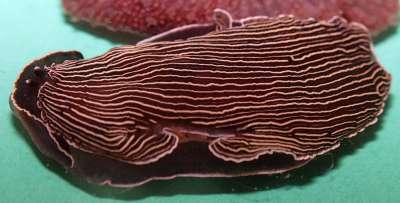
Armina abbotti
Thompson, Cattaneo & Wong (1990)
Order: NUDIBRANCHIA
Suborder: ARMININA
Family: Arminidae
DISTRIBUTION
South Carolina, Florida - probably wider Caribbean distribution
PHOTO
Apalachicola Bay, northwestern Florida. Photo: Kelly Hooper.
This is apparently a fairly common nudibranch in soft-bottom subtidal environments in the southeastern USA. It has usually been identified as the Mediterranean species Armina tigrina, but Thompson et al (1990) while reviewing Mediterranean arminids, named it Armina abbotti after Tucker Abbott who published an early account of its biology. A much fuller account of its anatomy and biology was later published by Eyster (1981).
It has a dark reddish brown to black background colour. There mantle has many longitudinal ridges which are edged with white or yellow. The rhinophores are black with white tips and the oral veil, foot and mantle are all edged with white or pale yellow. It is similar to Armina juliana but
according to Ardila & Diaz (2002) it differs in tooth shape and number of mantle ridges. It lives in sandy subtidal areas and feeds on the pennatulacean Sea Pansy Renilla reniformis Pallas. It grows to more than 5cm long.
References:
• Abbott, R.T. (1954) The habits and occurrence of the nudibranch Armina tigrina in southeast United States. The Nautilus, 67(3): 83-86
• Ardila, N. E. & Díaz, J.M. (2002) Armina juliana (Gastropoda: Nudibranchia: Arminidae), a new species from the southern Caribbean. Bol. Instituto de Investigaciones Marinas y Costeras, 31: 25-31.
• Bertsch, H (1968) Effect of feeding by Armina californica on the bioluminescence of Renilla koellikeri. The Veliger, 10(4): 440-441.
• Eyster, L.S. (1981) Observations on the growth, reproduction and feeding of the nudibranch Armina tigrina. J. Moll. Stud., 47: 171-181.
• Thompson, T.E., Cattaneo, R. & Wong, Y.M. (1990) Eastern Mediterranean opisthobranchia: Dotidae (Dendronotoidea), Arminidae and Madrellidae (Arminoidea). J. Moll. Stud., 56: 393-413.
Rudman, W.B., 2004 (March 8) Armina abbotti Thompson, Cattaneo & Wong (1990). [In] Sea Slug Forum. Australian Museum, Sydney. Available from http://www.seaslugforum.net/find/armiabbo
Related messages
Armina from the Gulf of Mexico
June 22, 2007
From: Gary Gray
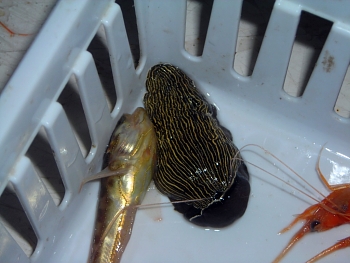
Hello!
Can anyone identify this specimen? It is sitting next to an Atlantic Midshipman and a shrimp.They were brought up in a trawl about 15 miles east of the Main Pass of the Mississippi River and 25 miles south of the Chandeleur Islands.
Locality: Southeast Breton Sound, 22 metres, Louisiana, U.S.A., Gulf of Mexico, 13 June 2007, Sand and mud. Length: 43 mm. Photographer: Stephanie Taylor.
Thanks for your help.
Gary Gray
gary.gray@usm.edu
gary.gray@usm.edu
Gray,G.J., 2007 (Jun 22) Armina from the Gulf of Mexico. [Message in] Sea Slug Forum. Australian Museum, Sydney. Available from http://www.seaslugforum.net/find/20057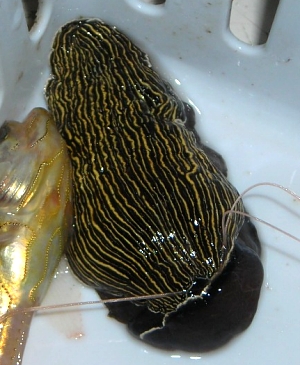
Dear Gary,
This is a species of Armina, many species of which feed on sea pens [Pennatulacea]. I suspect your animal is a species I have identified on the Forum as Armina abbotti but I must warn you there is not total agreement on its identity [See Néstor Ardila's message #12433 suggesting it is a synonym of Armina muelleri]. I am afraid this is one of those occasions when the original descriptions of species are so poor that it is probably impossible to be sure just what a name means. Armina muelleri was described from southern Brazil by Ihering (1886) but as I say on the Fact Sheet, the description was not adequate and the type specimen is lost. Marcus & Marcus (1970) examined specimens from Sao Paulo which they tentatively identified as A. muelleri mainly on the grounds that their animals were also from Brazil. So essentially we don't really know what A. muelleri is.
In the meantime an Armina was being found in the southeastern USA and identified as the Mediterranean A. tigrina. Thompson et al (1990) argued it wasn't that species and named it A. abbotti. A third species, Armina wattla, with a distinctive black mark on the head, has also been reported from the region. However Ardila & Valdes (2004) considered A. abbotti and A. wattla to both be synonyms of A. muelleri despite the uncertainty surrounding that name. Even more puzzling is that in the recent Caribbean book (Valdes, Hamann, Behrens & DuPont 2006) Armina muelleri and A. wattla are accepted as distinct species and A. abbotti is considered a synonym of A. wattla. In this book, your animal is identified as A. muelleri. [I've only included one reference below, the rest will be found on the relevant pages on the Forum.]
I can't really advise you on what name to use. Firstly, there seem to be many species of Armina with very similar external colour patterns and no one has ever had enough material of any one species to determine how variable they can be in colour. Secondly, I don't see how we are going to resolve the identity of A. muelleri. Personally I would stick with the name Armina abbotti because it can be identified with this relatively common animal from southeastern USA because it may be many years before the taxonomists know enough about this family to sort out these names.
- Ardila, N. E. and Valdés, A. (2004) The genus Armina (Gastropoda: Nudibranchia: Arminidae) in the southern Caribbean, with the description of a new species. The Nautilus 118: 131-138.
Best wishes,
Bill Rudman
Armina abbotti from NW Florida
March 10, 2004
From: Kelly Hooper

Hi Bill,
I have another nudibranch that I need some help identifying from Apalachicola Bay, northwestern Florida. The only thing I can find that looks remotely close is Hypselodoris edenticulata but it seems the link is mostly in color and not morphology. I have yet to see any rhinophores or cerata. It has one pair of small eyes. They look like eyes at least. The gills seem to be along either side under the mantle.. It is a real dark maroon with thin yellow stripes. It loves to eat sea pansies (Renilla spp - see lower left photo). They get pretty large, more than two inches. I am attaching four pictures. I have its eggs but during the transfer to get the picture they lost their form so I didn't send any pictures of them. I again appreciate all your knowledge and help.
Thanks,
Kelly Hooper
kelly.hooper@fwc.state.fl.us
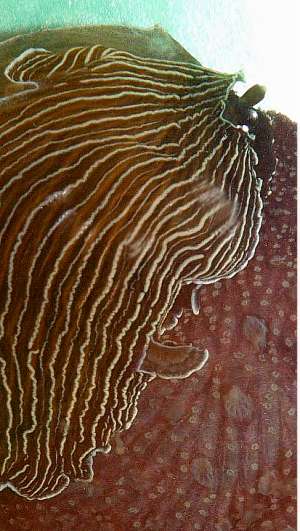
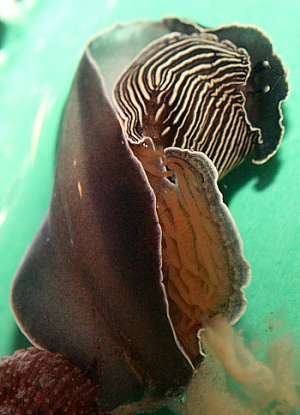
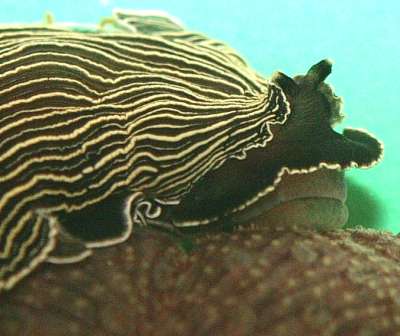
Dear Kelly,
This is apparently a fairly common nudibranch in soft-bottom subtidal environments in the southeastern USA. It has usually been identified as the Mediterranean species Armina tigrina, but Thompson et al (1990), while reviewing Mediterranean arminids, named it Armina abbotti after Tucker Abbott who published an early account of its biology. A much fuller account was later published by Eyster (1981) from animals studied in South Carolina. I was intersted in your mention of it feeding on Renilla. Most species of Armina feed on sea pens [order Pennatulacea] or the related sea pansies such as Renilla. The Californian species Armina californica is reported to cause a spectacular 'light show' when it feeds on the bioluminescent species Renilla koellikeri.
The anatomy of arminds is a bit different from the aeolids and dorids you are more familiar with. I have included a close-up alongside of the head, where you can see the two little rhinophores [they are black with white tips]. It's hard to see here, but in most arminids the rhinophores have a few vertical lamellae rather than the horizontal or transverse lamellae found in many dorids. Have a look at the rhinophore page for some examples. Concerning gills. On the underside of the mantle skirt you will find two types of folds or lamellae. As you can see in the lower left photo, the posterior two-thirds of the underside of the mantle has brownish longitudinally arranged folds, which contain branches of the digestive gland. These are called hyponotal lamellae or lateral lamellae but unfortunately the names of these structures differ from publication to publication. In front of these hyponotal lamellae, there is a transverse band of more delicate lamellae on each side, running from the side of the body out to the mantle edge. These are considered to be the gills [branchial lamellae]. Have a look at the Fact Sheet for Armina juliana for a photo of the underside of an arminid.
• Abbott, R.T. (1954) The habits and occurrence of the nudibranch Armina tigrina in southeast United States. The Nautilus, 67(3): 83-86
• Bertsch, H (1968) Effect of feeding by Armina californica on the bioluminescence of Renilla koellikeri. The Veliger, 10(4): 440-441.
• Eyster, L.S. (1981) Observations on the growth, reproduction and feeding of the nudibranch Armina tigrina. J. Moll. Stud., 47: 171-181.
• Thompson, T.E., Cattaneo, R. & Wong, Y.M. (1990) Eastern Mediterranean opisthobranchia: Dotidae (Dendronotoidea), Arminidae and Madrellidae (Arminoidea). J. Moll. Stud., 56: 393-413.
